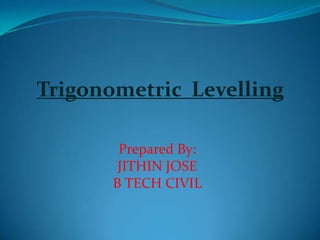
Trigonometric levelling jithin
- 1. Trigonometric Levelling Prepared By: JITHIN JOSE B TECH CIVIL
- 2. INTRODUCTION Definition: “ Trigonometric levelling is the process of determining the differences of elevations of stations from observed vertical angles and known distances. ” The vertical angles are measured by means of theodolite. The horizontal distances by instrument Relative heights are calculated using trigonometric functions. Note: If the distance between instrument station and object is small. correction for earth's curvature and refraction is not required.
- 3. METHODS OF DETERMINING THE ELEVATION OF A POINT BY THEODOLITE: Case 1. Base of the object accessible Case 2. Base of the object inaccessible, Instrument stations in the vertical plane as the elevated object. Case 3. Base of the object inaccessible, Instrument stations not in the same vertical plane as the elevated object.
- 4. Case 1. Base of the object accessible B A = Instrument station R.L. of B = R.L. of B.M. + Bs + h B = Point to be observed = R.L. of B.M. + Bs + D. tan h = Elevation of B from the instrument axis If distance is large than add Cc & Cr D = Horizontal distance between A and the base of object R.L. of B = R.L. of B.M. + Bs + D. tan + 0.0673 D2 h1 = Height of instrument (H. I.) Bs = Reading of staff kept on B.M. = Angle of elevation = L BAC h = D tan
- 5. Case 2. Base of the object inaccessible, Instrument stations in the vertical plane as the elevated object. There may be two cases. (a) Instrument axes at the same level (b) Instrument axes at different levels. 1) Height of instrument axis never to the object is lower: 2) Height of instrument axis to the object is higher:
- 6. Case 2. Base of the object inaccessible, Instrument stations in the vertical plane as the elevated object. (a) Instrument axes at the same level PA P , h= D tan 1 PB P , h= (b+D) tan 2 D tan 1 = (b+D) tan 2 D tan 1 = b tan 2 + D tan 2 D(tan 1 - tan 2) = b tan 2 R.L of P = R.L of B.M + Bs + h
- 7. (b) Instrument axes at different levels. 1) Height of instrument axis never to the object is lower: PA P , h1 = D tan 1 PB P , h2 = (b+D) tan 2 hd is difference between two height hd = h1 – h2 hd = D tan 1 - (b+D) tan 2 = D tan 1 - b tan 2 -D tan 2 hd = D(tan 1 - tan 2) - b tan 2 hd + b tan 2 = D(tan 1 - tan 2) h1 = D tan 1
- 8. (b) Instrument axes at different levels. 2) Height of instrument axis to the object is higher: PA P , h1 = D tan 1 PB P , h2 = (b+D) tan 2 hd is difference between two height hd = h2 – h1 hd = (b+D) tan 2 - D tan 1 = b tan 2 + D tan 2 - D tan 1 hd = b tan 2 + D (tan 2 - tan 1 ) hd - b tan 2 = D(tan 2 - tan 1) - hd + b tan 2 = D(tan 1 - tan 2) h1 = D tan 1
- 9. In above two case the equations of D and h1 are, D h1
- 10. Case 3. Base of the object inaccessible, Instrument stations not in the same vertical plane as the elevated object. Set up instrument on A Measure 1 to P L BAC = Set up instrument on B Measure 2 to P L ABC = L ACB = 180 – ( + ) Sin Rule: b· sin BC= sin{180˚ - ( + )} b· sin AC= sin{180˚ - ( + h1 = AC tan 1 h2 = BC tan 2
- 11. THANK YOU
